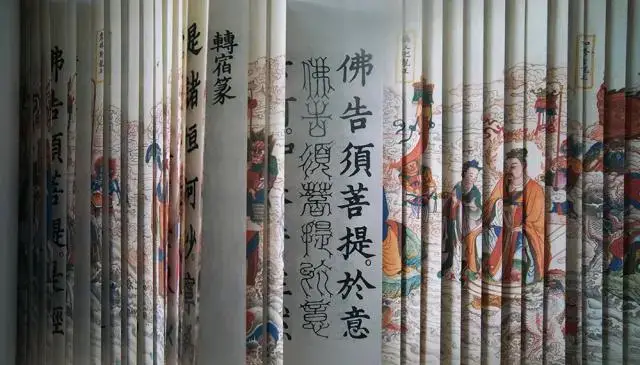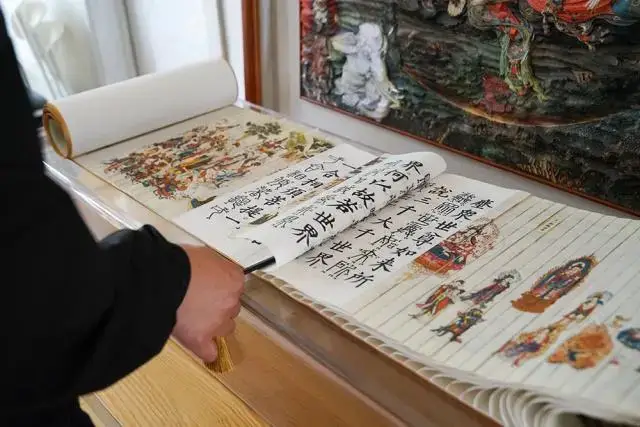“Dragon Scale Binding,” also known as “Dragon Scale Pattern Binding” or “Whirlwind Binding,” is a form of ancient Chinese bookbinding. Its distinctive feature involves folding the pages of a book in a zigzag pattern, then connecting them using fish-tail paper. The pages are sequentially adhered, resulting in a long, dragon-scale-like pattern. This form of bookbinding possesses a unique artistic style and historical significance, constituting an essential part of ancient Chinese culture.
Origin and Evolution of Dragon Scale Binding
The origin of Dragon Scale Binding can be traced back to the Tang Dynasty, evolving gradually with the invention and popularization of printing technology. Initially, people adhered paper with written text together to form a scroll, facilitating ease of writing by drawing boundaries on the lengthy paper. Over time, a quest for more aesthetically pleasing and practical binding forms led to the development of Dragon Scale Binding.

Whirlwind Binding evolved from scroll binding, resembling a scroll with a long piece of paper as the base. The first leaf is fully pasted onto the base, and subsequent leaves are adhered one by one from right to left, creating a whirlwind-like effect. When viewed externally, it appears like a regular scroll, but the internal pages are arranged in a whirlwind pattern, earning it the name Whirlwind Binding or Dragon Scale Binding. This binding style emerged in the late Tang to Five Dynasties period, meeting the need for convenient reading and preservation while satisfying evolving artistic and cultural expectations.
The initial Dragon Scale Binding involved folding pages and connecting them with fish-tail paper, creating a dragon-scale pattern. This not only facilitated reading and preservation but also enhanced the aesthetic and artistic value of the books. As time passed, variations of Dragon Scale Binding emerged, introducing different forms such as butterfly binding and wrapped-back binding.
Characteristics and Craftsmanship of Dragon Scale Binding
Dragon Scale Binding is characterized by its unique binding form and craftsmanship. Firstly, the folding of pages follows a zigzag pattern, enhancing both the visual appeal and readability of the book. Secondly, the pages are connected using fish-tail paper, sequentially adhering them to form a long dragon-scale-like pattern. This binding method not only aids preservation but also elevates the artistic value of the books.

The craftsmanship of creating Dragon Scale Binding involves multiple steps such as folding, cutting, and adhering. Initially, papers are folded following specific patterns, offering flexibility in choice. Subsequently, the folded papers are cut to ensure uniform size. Then, fish-tail paper is used to adhere the folded pages sequentially, forming the dragon-scale pattern. Finally, decorative elements such as stickers or paintings may be added to enhance the overall appearance.
Impact and Value of Dragon Scale Binding
As a form of ancient Chinese bookbinding, Dragon Scale Binding holds profound influence and historical value. Firstly, its emergence signifies the diversification of ancient Chinese bookbinding forms, providing convenience for reading and preservation while enhancing the artistic and aesthetic appeal of books. Secondly, Dragon Scale Binding has positively contributed to the development of Chinese ancient culture. The unique form and craftsmanship have increased the artistic and collectible value of books, promoting cultural and artistic exchange and development.
Moreover, Dragon Scale Binding continues to have relevance in modern times. In art exhibitions and cultural events, replicas of ancient Dragon Scale Binding are often used as decorations or exhibits, allowing audiences to gain a more intuitive understanding of the development and evolution of ancient Chinese culture. While modern printing technologies have moved away from Dragon Scale Binding, considering it as a cultural heritage, it is still widely studied and preserved.
Interpretations of Dragon Scale Binding
There are three prevailing interpretations of Dragon Scale Binding. Firstly, some believe it originated from the folding of ancient books known as “经折装” (Jīng zhé zhuāng) or “Whirlwind Binding.” This suggests that Dragon Scale Binding is synonymous with Whirlwind Binding or a form of folded binding.

Secondly, it is considered an evolution from folded binding. Scholars propose that, after the appearance of folded binding, people discovered its tendency to unfold and break easily. To address this, a method using a large piece of paper folded in half, with one half pasted on the first leaf and the other wrapped around from the right side to the back, sequentially adhering subsequent leaves, was developed. This method avoided the risk of pages unfolding or tearing during handling. When flipping through the book from right to left, it gave the impression of continuous swirling, hence the name Whirlwind Binding.
Thirdly, it is seen as a transitional form from scroll binding to leaf binding. In this interpretation, Dragon Scale Binding involves a long strip of paper as a base, with the first leaf fully pasted on the right side. The remaining leaves are sequentially adhered with a narrow strip of paper on the right side, creating a staggered pattern. When rolled up, it resembles a scroll, but the internal pages rotate in a single direction, resembling a whirlwind, thus earning the name Whirlwind Binding or Dragon Scale Binding.
Conclusion
In conclusion, “Dragon Scale Binding” represents a unique form of ancient Chinese bookbinding, bearing profound influence and historical value. It not only facilitates reading and preservation but also enhances the artistic and aesthetic value of books. As part of cultural heritage, the study and preservation of Dragon Scale Binding are of significant importance for the inheritance and promotion of Chinese culture. The craftsmanship and processes involved in Dragon Scale Binding provide valuable cultural and artistic resources. It is essential to prioritize and strengthen efforts in the protection and inheritance of Dragon Scale Binding, ensuring the continuation and development of this unique cultural heritage.